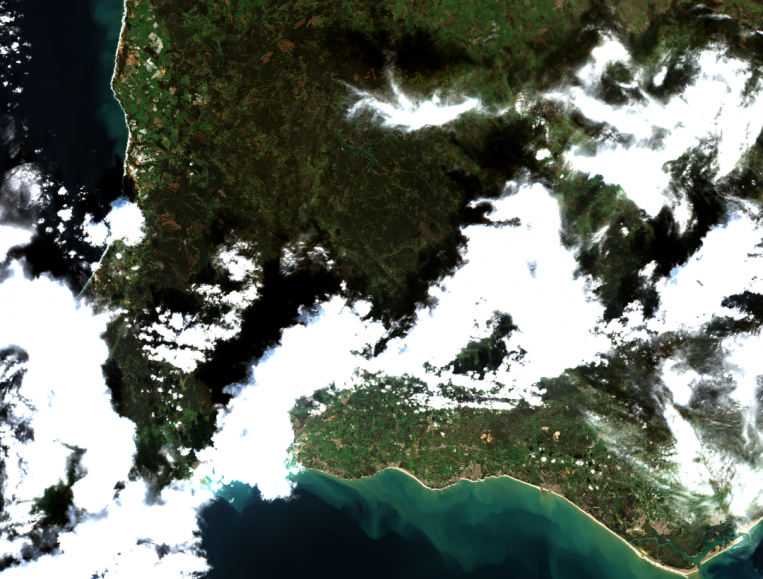Aquascope Solutions Ltd
19 Leyden Street
London
E1 7LE
United Kingdom
Oxford Molecular Biosensors Ltd
Centre for Innovation & Enterprise
WheelRight
OX5 1PF
United Kingdom
Water Resource Associates LLP
PO Box 838
Wallingford
OX10 9XA
United Kingdom
Monitoring crops from space supports the Portuguese government and farmers
Satellite data is increasingly being used in agriculture for precision farming, enabling crop health monitoring and informing more accurate decisions in a variety of areas including watering, the application of fertilisers and pesticides, and many others.
In Portugal, with its Aquafarm project, Hidromod is targeting another vital aspect of farming: the validation of subsidies claimed through the European Union’s Common Agricultural Policy (CAP), and efficient water management, with support from ESA through a Business Applications Kick-Start study and follow-on Demonstration Project.
Satellite data can play a significant role in helping farmers grow better crops and optimise harvesting. In a country such as Portugal, where a significant proportion of the land is used for agriculture, external competition at cheaper prices hasn’t persuaded buyers to abandon local produce. Nevertheless, CAP subsidies are still vital for farmers. Ensuring that the subsidies are going to the right place is a major challenge for Portugal’s Institute of Finance for Agriculture and Fish (IFAP).
Hidromod is tackling this issue with its Aquafarm project, which uses Sentinel-2 satellite optical data and Landsat 8 data to provide remote crop monitoring. In the context of its Business Applications programme, ESA initially supported Hidromod to develop the service through a Kick-Start activity which was then followed by the Aquafarm 2.0 Demonstration project, due to be completed in 2023. However, the project has been so successful that in June 2021 IFAP already signed a 2-year contract with Hidromod for the service.
According to Rita Rinaldo, head of project and studies implementation at ESA “The Aquafarm 2.0 journey from study to project to commercial service highlights one of ESA Business Applications and Space Solutions’ strengths: to support companies from an early application concept to operating as a viable service”.
Verifying CAP payments
Through the CAP policy, farmers receive direct payments to support them in the way they manage their farms for the benefit of the wider population, for example in work done to protect the environment. CAP payments also provide additional support to regions where conditions are difficult and to help young people take up farming.
There is an increasing emphasis on technological innovation, digitisation and research and development designed to encourage positive environmental changes. Farmers taking this approach can access additional financing because, under the revised CAP policy, the amount they receive will depend not only on the size of the area they farm, but also on the farm’s impact on the environment and/or climate.
In Portugal, IFAP controls the CAP payments. Its mission is to validate and fund the implementation of national and EU measures in agriculture, rural development, fisheries and related sectors. However, it is impossible to physically inspect every farm across the country to check whether the crops declared by farmers are the ones actually being grown.
Not only can this lead to subsidies being wrongly attributed, but if discovered, can result in compulsory refunds of subsidies back to the EU. IFAP therefore wanted to use a system that would help it distinguish between agricultural and non-agricultural land, and then identify the individual ‘parcels’ of agricultural land – around 4 million parcels across Portugal – and the crops being grown on each one.
As explained by vice-president of IFAP, Nuno Moreira, the processing of Copernicus Sentinel satellite images has allowed the monitoring and identification of crops and the validation of individual claims for agriculture funds, with obvious advantages in the quantity and quality of control, as well as knowledge of the agriculture being carried out and support for the definition of agriculture policies.
Providing support to farmers in efficient water management
But Aquafarm 2.0 is used for much more than verifying CAP payments. Aquafarm 2.0 integrates data from satellites with meteorological models and measurements as well as plant growth models to provide results about plants and soil. The platform is connected to in situ data and ‘learns’ using historical data in order to increase the accuracy of its forecasts of crop development and water use. In particular, it detects the crop type and is able to predict when and where water is and will be consumed by plants. These type of predictions help farmers and water managers to ensure that there is a more efficient and sustainable use of water in agriculture.
Aquafarm’s features also make it attractive for farmers, enabling them to maximise production by proactively addressing any identified stress factors in their crops. As part of the Demonstration Project, Hidromod is working with two companies that provide such services to farmers – Wisecrop and EDIA – to address this market.
Pedro Chambel Leitão, Aquafarm project manager, said “What truly impressed me in regards to the collaboration with ESA is that it was not only about selling satellite images. It was addressing the world's agricultural challenges together and adjusting and shaping where the satellite images can and can’t be used in order to achieve Aquafarm’s ambition to support crop and efficient water management.”
Rita Rinaldo added: “Water resources are heavily impacted by climate change and water-related challenges are one of the priorities of the COP27 agenda. Water is at the heart of climate adaptation and resilience. At the same time, water security is a necessary element of food security and soil protection. We are working alongside Hidromod and partners to introduce innovative measures in support of new practices for water management in the agri-food sector, leveraging on integrated space solutions.”
ESA project supports improvements in child cancer care in Iraq

A new research paper analysing the results of the Simona Project shows that the provision of information and expertise from a hospital in Italy has clearly improved the diagnoses and management of paediatric cancer at the primary childhood oncology unit in Iraq.
By the early 2000s, healthcare in Iraq had suffered after decades of war and economic sanctions. One of those to respond was paediatric haematologist Dr. Anna Maria Testi from Sapienza University of Rome, Italy, who set up the Simona Project (later renamed TOGETHER) after a visit to Baghdad in 2003. This enabled paediatric oncologists at the Sapienza University of Rome to provide up-to-date medical information and services to the Children’s Welfare Teaching Hospital (CWTH) in Baghdad via satellite.
Over 12 years of collaboration between the two hospitals took place, 1182 patients aged up to 16 years old at CWTH received care through the project, including 500 whose cases were discussed during teleconsultation sessions.
It took place Under the coordination of the Telemedicine service provider Telbios, with the involvement of the Italian humanitarian aid organisation INTERSOS, the Policlinico Umberto I Haematology Department at Sapienza University of Rome and the Children Paediatric Hospital. In Iraq Mazin Al-Jadiry and Salma Hadad worked on the project.
The benefits of twinning and telemedicine
The research paper "'Comprehensive global collaboration in the care of 1182 pediatric oncology patients over 12 years: The Iraqi-Italian experience'", which was recently published in the journal Cancer Medicine, notes that “Twinning and telemedicine are proven strategies to improve care, speed the process of change and introduce new medical concepts in developing countries”. The positive results from the Simona project clearly align with this observation.
The teleconsultations enabled by ESA’s project, along with tele-education, exchange visits and the provision of second opinions on pathological findings, had a measurable effect on patient care. In some cases diagnoses were changed, as were treatment regimens and supportive care measures. The overall outcome included decreases in mortality, toxicities, infections and relapse rates. There was also a reduction in the rates of patients abandoning treatment, which was attributed to improved parental trust based on their awareness of the alliance with the Italian team.
“Long-term initiatives such as this collaboration between two medical facilities in different countries can make a difference to so many lives,” said Francesco Feliciani, Head of Companies-Led Projects Section at the Downstream Business Applications Department at ESA.
“Satellites can bring together experts across continents to enable them to support each other and thereby support their patients – on a practical level this simply can’t happen in any other way with such frequency and for so many years. ESA is proud to have supported the Simona Project and to know we’ve made a difference to the lives of so many children in Iraq.”
Meanwhile Mazin Faisal Al-Jadiry, assistant professor of paediatrics at the University of Baghdad said that the project has “helped to improve the diagnostic skills of our pathologists and as we are a tertiary and teaching centre the upgrading of the diagnostic skills will help to disseminate this experience to other parts of Iraq and to the new generations of pathologists and oncologists.”
The Simona Project is believed to have facilitated the most comprehensive telemedicine collaboration in paediatric oncology. Although the project has been finished for some time now, the positive outcomes are being maintained due to the improvements in knowledge and skills among the staff at CWTH.
ESA announces new green finance partnership with UK CGFI

The European Space Agency (ESA) this week announced a partnership with the UK Centre for Greening Finance and Investment (CGFI). The partnership, created under ESA’s Space Solutions programme, is part of ESA’s 'Finance for a green transition' initiative and will accelerate the uptake of green space-based solutions to support the financial sector with the green transition.
ESA has established this long-term collaboration with CGFI to promote the development of new space-enabled commercial services for the financial services sector, providing support to financial, climate and environmental analytics providers across Europe. Ultimately these solutions will help financial institutions understand and mitigate the financial implications posed by the transition to a net-zero, nature positive economy and help companies and projects attract investment as part of green transition initiatives.
Speaking at a networking event organised by CGFI, ESA’s Head of Space Solutions Nick Appleyard said ‘Green finance applications are of interest not only to financial institutions but also to organisations across many other sectors including energy and utilities, agriculture, transportation and manufacturing. This new partnership will support financial, climate and environmental analytics providers across Europe and help companies attract capital and investment for space-based solutions.’
Christophe Christiaen, Innovation and Impact lead at CGFI, said “Space-based datasets can provide financial institutions with asset-level insights across a wide range of climate and environmental issues, complementing corporate disclosures and bringing transparency where previously there was none. We have been promoting and developing the concept of ‘Spatial Finance’ for a couple of years now and are excited to partner with ESA and its ecosystem to further accelerate the adoption of these technologies for green finance.”
Earth observation, satellite communications and satellite navigation play a key role in analysing climate and environmental risks, impacts and opportunities. By using satellite-based data, financial institutions have an independent and transparent set of data to help companies move towards a net-zero economy. These data sets can also help attract the necessary capital and investment for organisations’ transition plans and investment needs, informing and influencing their investors and stakeholders.
This new partnership will combine ESA’s technical, commercial and financial support around space solutions with CGFI’s expertise in green finance and climate science, helping organisations manage climate risks and improve their environmental impact to facilitate growth in the sector. Incorporating expert advice resulting from this new partnership, ESA is preparing a new dedicated funding opportunity aimed at companies with promising business ideas for products and services tailored to green finance. Further details can be found on the ESA Space Solutions webpage 'Finance for a Green Transition'.



